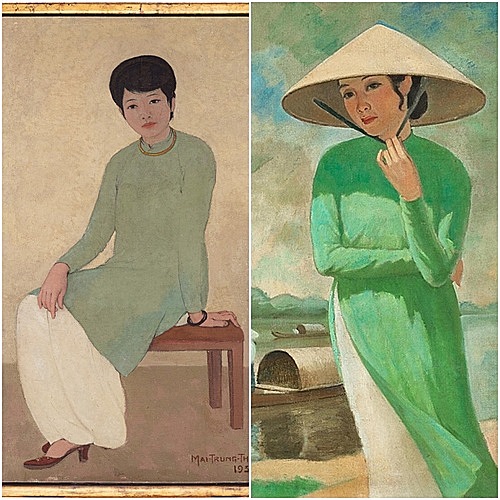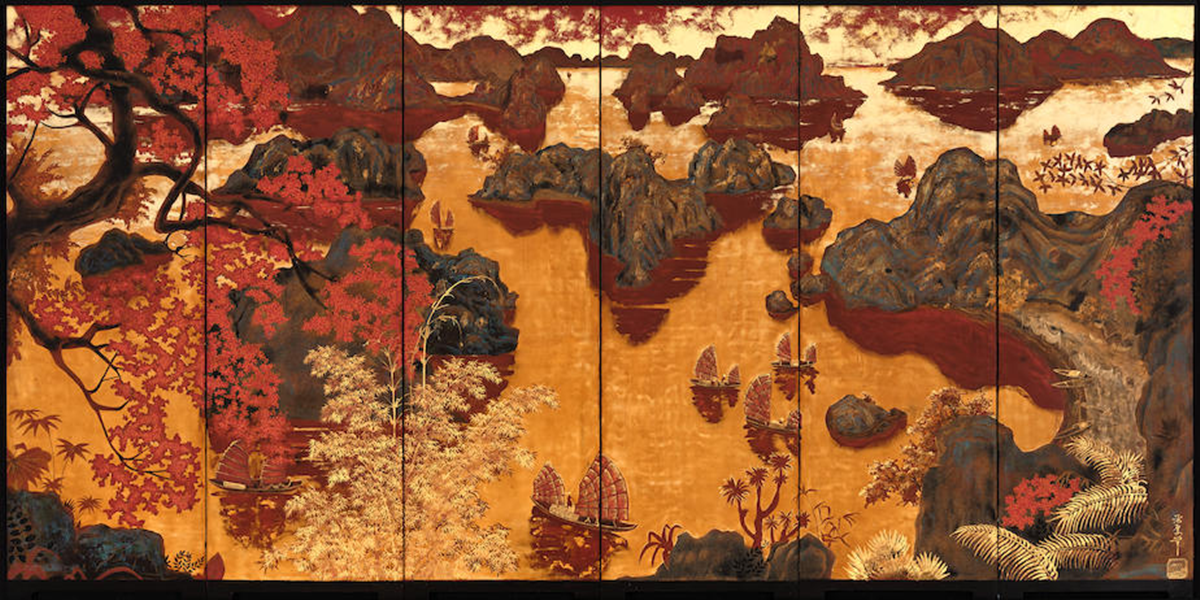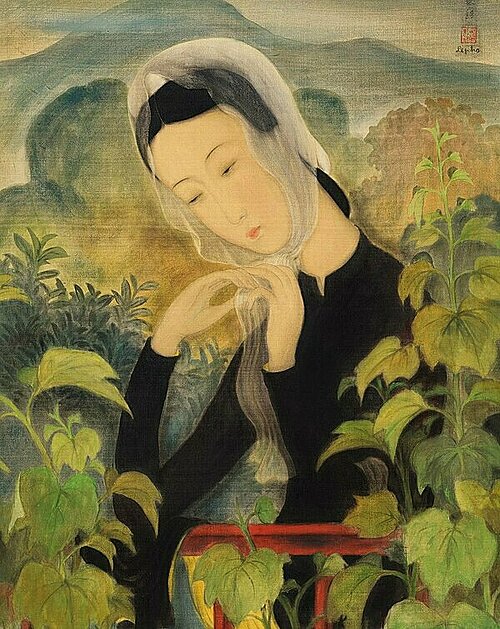Eight Vietnamese artworks went under the hammer for millions of dollars at various international auction houses this year, marking increasing acknowledgement of artistic talent in the country.
Despite Covid-19 impacts on the global art market, Vietnamese artworks achieved significant success at international auctions this year.
From 2017, the first time a Vietnamese artwork fetched $1 million or more at an international auction, until 2020, there were only four pieces that achieved this milestone.
Artist Mai Trung Thu became a phenomenon after three of his paintings were sold for over $1 million each.
In particular, the ‘Portrait of Mademoiselle Phuong’ and ‘Femme au Chapeau Conique le Long de la Rivière’ (Young Woman With A Conical Hat By The River) fetched the two highest bids for Vietnamese paintings at $3.1 million and $1.57 million, respectively, in Hong Kong auctions.
 |
|
‘Portrait of Mademoiselle Phuong’ and ‘Femme au Chapeau Conique le Long de la Rivière’ by Mai Trung Thu. Photo courtesy of Sotheby’s |
Thu (1906-1980), devoted himself mainly to silk paintings and the two oil paintings that fetched record bids are rare works. Only seven are recorded to have appeared at auctions.
The ‘Portrait of Mademoiselle Phuong,’ a 135.5×71 cm oil on canvas work done in 1930, was sold at Sotheby’s Auction House in April.
Fine arts researcher Ngo Kim Khoi described the ‘Portrait of Mademoiselle Phuong’ was the “Mona Lisa of Vietnam.”
The ‘Femme au Chapeau Conique le Long de la Rivière’ (Young Woman With A Conical Hat By The River) was also sold at an auction held by Sotheby’s Hong Kong on Dec. 14. The work was created in 1937 during the artist’s last year in Vietnam, demonstrating his ability to combine painting techniques.
An outstanding silk painting by Thu, ‘Choi Dan Nguyet’ (Lady Playing a Nguyet Cam) fetched $1 million at Hong Kong’s Bonhams auction in November.
Curator Yunwen Sung with the NUS (National University Of Singapore Centre For the Arts commented that the painting blends the artist’s training in Vietnam with his artistic adventures in Paris.
The work was displayed at the Trois Peintres Indochinois (The Three Indochinese Painters) exhibition at Henri Joly’s gallery in Paris, December 1943.
Artists Pham Hau, Le Quoc Loc, and Le Pho also made their international mark with a series of million-dollar works.
Three lacquer paintings went under the hammer this year, making Hau the Vietnamese artist with the most million-dollar painting bids; with four artworks achieving that distinction.
 |
|
‘Hoang Hon Vang Tren Vinh Ha Long’ by painter Pham Hau. Photo courtesy of Bonhams |
Recently, his ‘Hoang Hon Vang Tren Vinh Ha Long‘ (Golden Sunset Over Ha Long Bay) went under a Hong Kong hammer for around $1.25 million on the evening of Nov. 27.
The work was once owned by Vietnam’s last king, King Bao Dai (1913 – 1997) who’d ordered some paintings by Hau for his personal collection and as gifts for politicians.
The painting was given to Pulitzer Prize-winning American Journalist Edgar Ansel Mowrer (1892-1977) in 1951, when he visited Vietnam.
In June, Hau’s lacquer paintings ‘Thac Bo‘ (Landscapes with Junks) and ‘Phong Canh Chua Thay‘ (View of a Famous Old Pagoda’s landscape in North Vietnam’) were sold for $1 million each by French auction house Aguttes and Sotheby’s Hong Kong.
The two paintings are large and wide screens, depicting the grandeur of vast natural landscapes.
The artist has used many layers of colors to create depth and balance. Strict about composition, he has combined the artistic style widely used in the Indochina Fine Arts School and mixing with Eastern and Western art.
The ‘Paysage de Phnom Penh‘ (Landscape of Phnom Penh) by Painter Le Quoc Loc (1918 – 1987) was sold for $1.4 million by French auction house Millon in October.
The eight-panel lacquered screen was created in 1943, the year the artist graduated from the Indochina College of Fine Arts.
It is made from natural materials like wood, gold leaf, and eggshells, creating a feeling of warmth and peace. The two main colors are yellow – symbolizing spirituadlity and happiness, and red – adding life and warmth.
Le Pho (1907-2001) also contributed to the higher valuation nof Vietnamese art when his ‘Jeune femme attachant son foulard‘ (Young Lady Tying Her Scarf) pocketed $1.1 million at a Christie’s Hong Kong in May.
The masterpiece, created in 1938, is a 59.5 x 48.5 centimeter ink and gouache work on silk with Pho’s signature in the upper right corner. The artist captures the ethereal beauty of women with northern cultural motifs.
 |
|
‘Jeune femme attachant son foulard’ (Young Lady Tying Her Scarf) by Le Pho. Photo courtesy of Christie’s |
The rise in demand for buying, selling and collecting paintings by painters of the Indochina period has contributed to boosting the value of Vietnamese artworks.
Mai Trung Thu, Pham Hau, Le Pho and others are all alumni of the Indochina Fine Arts College.
According to some industry leaders, most of the works of this period are owned by foreign collectors, especially France. Their choosing to sell some them has boosted market demand for Vietnamese artworks with regular offerings made these days by Sotheby’s, Bonhams, Christie’s, Lynda Trouvé and other art houses.
Vu Tuan Anh, media director of Viet Art Space, said: “Over time, paintings of Indochina painters have become increasingly rare in the market. They are expensive because they carrying historical stories and values.”
Bernadette Rankine – Southeast Asia director of Bonhams – said that in recent years, Vietnamese collectors have also tended to buy works of national artists.
She told Singapore’s Straitstimes that Vietnamese people have become active in buying paintings of local artists, especially of works that went abroad during the colonial period. At that time, foreigners bought these works during their stay in Vietnam and took them back home. Some of the paintings are now being repatriated by Vietnamese collectors.
Painter Le Thiet Cuong said that according to some sources, the buyers of both ‘Portrait of Mademoiselle Phuong’ and ‘Paysage de Phnom Penh’ are Vietnamese.
“This is an encouraging sign. In the end, local artworks still come back to Vietnam, not only paintings but also antiques,” he said.
In 2017, in a sure sign that Vietnamese artworks has arrived on the international scene, the New York Times commented that Vietnamese fine art “has never been more popular than now.”
- Reduce Hair Loss with PURA D’OR Gold Label Shampoo
- Castor Oil Has Made a “Huge” Difference With Hair and Brow Growth
- Excessive hair loss in men: Signs of illness that cannot be subjective
- Dịch Vụ SEO Website ở Los Angeles, CA: đưa trang web doanh nghiệp bạn lên top Google
- Nails Salon Sierra Madre
 VnExpress News The News Gateway of Vietnam
VnExpress News The News Gateway of Vietnam





